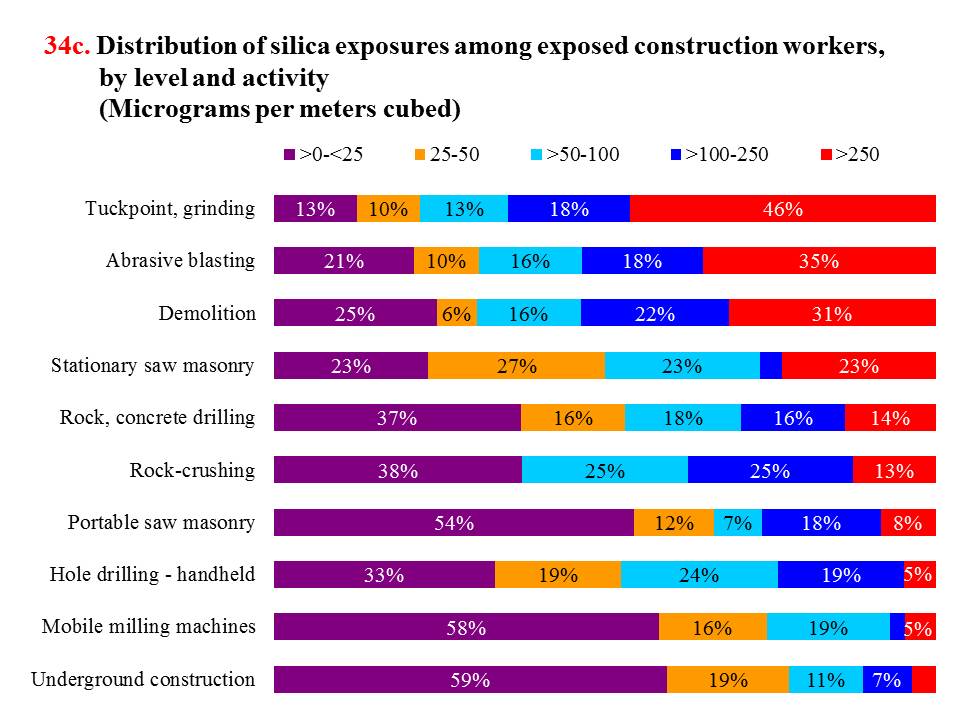Chart Book (6th edition): Hazards and Exposures – Exposure to Silica and Other Contaminants in Construction
34. Exposure to Silica and Other Contaminants in Construction
Silica is a common mineral found in many materials on construction sites, including soil, sand, concrete, masonry, rock, granite, and landscaping materials.1 Disturbing these materials can create crystalline silica dust.1 Workers who breathe in this dust are at increased risk of developing silicosis and other nonmalignant respiratory diseases, lung cancer, and kidney disease.2 To reduce silica exposure, the U.S. Occupational Safety and Health Administration (OSHA) adopted its first Permissible Exposure Limit (PEL) in 1971.3 However, silica exposure remains a serious threat to U.S. workers, especially for construction workers who frequently perform tasks that can create silica dust. OSHA reported that of 2.3 million workers who are exposed to silica hazards in their workplaces, the majority – an estimated 2 million – work in construction.4
To better protect construction workers, OSHA has issued new regulations for silica exposure, which include lowering the PEL for silica to 50 µg/m3 (micrograms per meter cubed), averaged over an 8-hour day.2 According to OSHA’s estimates, about 15% of construction workers are exposed to silica at or above 50 µg/m3, 9% at or above 100 µg/m3, and 4% at 250 µg/m3 or more (chart 34a). Furthermore, at every level of silica exposure, the percentage of construction workers exposed is higher than the exposure for workers in all industries.
Silica exposure varies by construction subsector. In the Highway, Street, and Bridge Construction subsector (NAICS 23730), 59% of workers are exposed to silica at certain levels, higher than any other subsector in construction (chart 34b). More than a quarter (26%) of workers in the Foundation, Structure, and Building Exterior Contractors subsector (NAICS 23810) are exposed to silica levels above the PEL (50 µg/m3), and as many as 10% are exposed at 250 µg/m3 or more.
Construction workers are exposed to silica when performing numerous tasks, such as abrasive blasting, tuckpointing, block and brick cutting, and grinding, drilling, cutting and chipping concrete. Some tasks increase the risks of exposure to silica more than others. About 78% of tuckpointers and grinders are exposed to silica levels above the PEL while performing these activities, and nearly half are exposed to more than 250 µg/m3 (46%; chart 34c). For workers performing abrasive blasting and demolition work, 69% are exposed at levels above the PEL and more than 30% are exposed above 250 µg/m3.
In addition to silica exposure, construction workers also face other contaminants in the workplace. Based on the O*NET occupational exposure ratings (see page 32), more than half of construction production occupations (see Glossary and page 11 for occupation classifications) are exposed to contaminants such as pollutants, gases, dust, or odors at least once a week (score of 75 or greater; chart 34d).
Exposure to silica dust and other contaminants can lead to serious, often fatal illnesses, which may be incurable, yet are preventable.1 OSHA published specified and alternative silica exposure control methods for the construction industry.4,5 CPWR’s website Work Safely with Silica provides information on how to recognize silica hazards and take actions to reduce silica exposure. In addition, industrial hygiene interventions such as proper tool inspection and replacement,1 local exhaust ventilation (LEV) systems,4 and use of wet processes6 have been demonstrated to be effective in reducing inhalational exposures.
(Click on the image to enlarge or download PowerPoint or PDF versions below.)
Glossary:
Production workers – In this chart book, production workers are the same as blue-collar workers. From the Current Population Survey: all workers, except managerial, professional (architects, accountants, lawyers, etc.), and administrative support staff. Production workers can be either wage-and-salary or self-employed workers.
1. CPWR – The Center for Construction Research and Training. Why is silica hazardous? https://www.silica-safe.org/know-the-hazard/why-is-silica-hazardous (Accessed January 2018).
2. Occupational Safety and Health Administration. 2017. OSHA’s respirable crystalline silica standard for construction, https://www.osha.gov/Publications/OSHA3681.pdf (Accessed December 2017).
3. Occupational Safety and Health Administration. 2014. Chemical management and permissible exposure limits (PELs), https://www.osha.gov/laws-regs/federalregister/2014-10-10 (Accessed December 2017).
4. Occupational Safety and Health Administration. 2016. Occupational exposure to respirable crystalline silica, Final rule. Federal Register, 81(58), https://www.gpo.gov/fdsys/pkg/FR-2016-03-25/pdf/2016-04800.pdf (Accessed December 2017).
5. Occupational Safety and Health Administration. 2017. Interim enforcement guidance for the respirable crystalline silica in construction standard, 29 CFR 1926.1153, https://www.osha.gov/pls/oshaweb/owadisp.show_document?p_table=INTERPRETATIONS&p_id=31349 (Accessed January 2018).
6. Carty P, Cooper M, Barr A, Neitzel R, Balmes J, Rempel D. 2017. The effects of bit wear on respirable silica dust, noise, and productivity: A hammer drill bench study. Annals of Work Exposure and Health, 61(6): 700-710.
Note:
Charts 34a-34c – The units on these charts are micrograms per meters cubed (µg/m3) of air.
Chart 34d – Exposure scores: 0 = Never; 25 = Once a year or more but not every month; 50 = Once a month or more but not every week; 75 = Once a week or more but not every day; and 100 = Every day.
Asterisk (*) refers to the Heating and Air Conditioning Mechanic occupation.
Source:
Charts 34a and 34b – Occupational Safety and Health Administration. 2016. Occupational exposure to respirable crystalline silica, Final rule. Table VII-5: Numbers of workers exposed to silica (by affected industry and exposure level (µg/m3)). Federal Register, 81(58): 16427-16432. Calculations by the CPWR Data Center.
Chart 34c – Occupational Safety and Health Administration. 2016. Occupational exposure to respirable crystalline silica, Final rule. Table VII-4: Distribution of silica exposures by application group and job category or activity – Final profile. Federal Register, 81(58): 16420. Calculations by the CPWR Data Center.
Chart 34d – O*NET OnLine. 2015. Work context – Physical work conditions, http://www.onetonline.org/find/descriptor/browse/Work_Context/4.C.2/ (Accessed May 2017).
